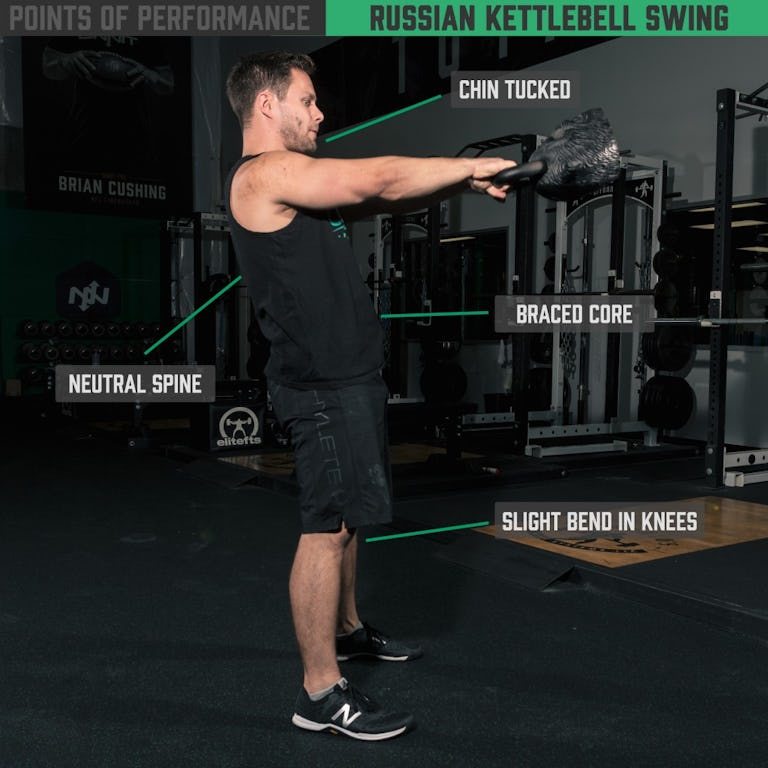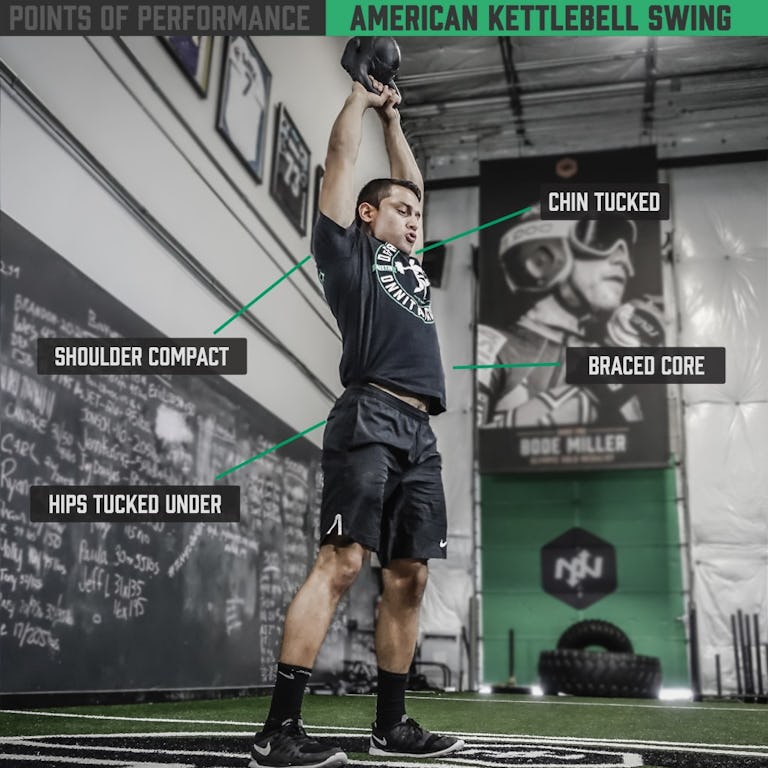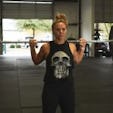If you follow the different kettlebell coaching factions out there in the fitness world, you might think that the U.S. and Russia are in the midst of another Cold War. Real political differences between the two nations aside, we’re talking about the conflict between the American and the Russian kettlebell swing—two versions of the basic swing exercise that kettlebellers use to build power and strength in the hips and posterior muscles.
Traditional kettlebell zealots favor the so-called Russian swing, where the weight is swung to around chest level with arms bent, while maverick coaches argue for the version that’s perhaps become more popular in America—swinging the weight clear overhead with arms extended.
We say both have their place and that, ultimately, the argument for one at the exclusion of the other is, like so many political debates, mere propaganda. We asked Onnit Director of Fitness Education, Shane Heins, to compare and contrast the two exercises so you can choose which side you wish to align yourself.
What’s The Difference Between The Russian Kettlebell Swing and The American Kettlebell Swing
(See 00:10 in the video above.)
“The father of modern kettlebell training who revitalized its use in the West is Pavel Tsatsouline,” says Heins. Beginning around the turn of the century, Tsatsouline—a coach of Eastern European origin—taught and popularized kettlebell training mechanics around the U.S. Pavel primarily demonstrated the Russian version of the swing, raising the bell to between waist and chest height, because that’s the way it was traditionally taught in Russia, the kettlebell’s motherland.
Heins notes that swinging in this fashion is less challenging to learn and more accessible to most people than swinging the weight overhead (the American style), and so this technique caught on. The swing in general gained a following because it was a simple way to add power to a training program—a quality that most general population fitness seekers ignore—as well as a good way to teach hip hinging. (Most of us bend at the waist and spine when we need to learn to drive our hips back).
“As awareness of kettlebell training grew, practitioners started exploring other variations of the swing,” says Heins, “with CrossFitters promoting a swing style where the arms travel overhead.” This has since come to be known as the American swing. “Naturally, controversy ensued about which version was the safest and most effective,” says Heins, “but if you really look at them, they’re essentially the same exercise, with some minor differences that make one a better choice for some people and the other the right choice for others.” To assure you that there really shouldn’t be any bad blood between the two sides, Heins notes that Pavel—the “Russian coach”—has also taught the American swing, and featured it in his programs. Peace at last…
How To Do The Russian Kettlebell Swing
For a really intricate look at the mechanics of the Russian swing (often just called the “kettlebell swing”), see our complete guide to the kettlebell swing. (Also, watch the video above, beginning at 3:30.) Once you’re familiar with the concept of the swing, it really boils down to two steps.
Step 1. Stand with feet between hip and shoulder width. You can place the kettlebell on the floor in front of you if you have experience hiking the weight back into position, or you can simply begin from a standing position—either are OK. In both cases, once the kettlebell is in hand, soften your knees and bend your hips back and allow the kettlebell to swing back in the triangular space between your knees and your crotch. You must begin each rep with the kettlebell in this triangle—any lower than your knees and you risk back injury and improper reps. Keep a long spine from the top of your head to your tailbone as you bend at the hips, and keep your head in neutral—focus your eyes on a spot about 10 feet in front of you on the floor.
Step 2. Drive your feet into the floor and extend your hips, tucking your pelvis under as you lock your hips and knees out and stand tall. Use your back muscles to keep your shoulders pulled down (away from your ears). Allow the power from your hips to raise the weight up to roughly chest level—don’t lift the weight with your shoulders. Your arms should stay tight to your sides at the top of the swing, but allow your elbows to bend as needed.
Take a few reps to gradually swing the kettlebell to its full height and find your rhythm.
Benefits of the Russian Kettlebell Swing
(See 14:30 in the video.)
The Russian kettlebell swing uses a shorter range of motion and doesn’t require good overhead body mechanics, so it’s ideal for using heavy weight and developing power. To be clear, you’ll be able to train heavier and build more hip extension strength and power with the Russian swing vs. the American one. Since it serves as a foundation for the American swing, it only makes sense for beginners to master the Russian version first.
How To Do The American Kettlebell Swing
The great challenge for many people when it comes to the American kettlebell swing is the overhead position. Can you raise your arms overhead without hyperextending your back? Can you get your arms vertical, or is your range of motion limited? Do you have any shoulder injuries that might make raising a weight straight overhead painful or uncomfortable? If the answer to any of the above is yes, then Heins suggests you hold off on the American swing for a bit while you work on shoulder and T-spine mobility and otherwise address any restrictions you have. Otherwise, if you’re good to go, here’s how to do it right (see 10:43 in the video).
Step 1. Set up exactly as you did for the Russian swing, and begin the exercise by swinging the weight back between your legs and then extending your hips.
Step 2. Instead of keeping your arms tight to your sides and bending the elbows, allow the power generated by your hips to let you drive the kettlebell overhead, extending your arms instead of holding the weight back. Let the kettlebell travel overhead—it should feel weightless as it goes vertical—and then control its descent back down.
Be careful that you keep your ribs pulled down, pelvis tucked, and core tight. If you allow your ribs to flare, you will hyperextend your back and will lose control of the swing as it moves overhead.
Benefits of the American Kettlebell Swing
The American swing takes the kettlebell over a greater range of motion, which is more challenging to total-body stability. Your core, as well as your overhead range, will be tested. It’s a great way to build strength in the shoulders as well as mobility that supplements any kettlebell pressing movements you do, and a fun variation to employ in general once you’ve got the Russian swing under your belt. What you sacrifice in power in the American swing you can make up for in work capacity. Because the range of motion is longer and the overhead position more precarious, the American swing doesn’t lend itself to heavy loads like the Russian one does. But it can be done for high reps and short rest periods, building your conditioning.
Should I Use The Russian or American Kettlebell Swing?
In the real Cold War between the U.S and the U.S.S.R., both sides were right… or, at least, thought they were right. The conflict between the Russian and American kettlebell swings, fortunately, is much easier to resolve. Try both, as both have their merits. If you’re a newbie to kettlebells, conquer the Russian swing. Likewise if you have shoulder troubles. But if you’re healthy and seeking a tougher conditioning workout with light weight, give the American version a go.



)






